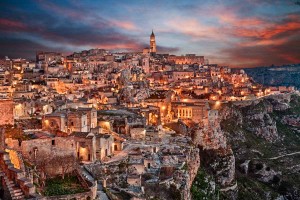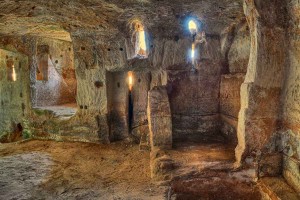
©Bigstock.com/ermess
You’re interested in the Stone Age? Well, you can always visit a museum displaying a few tools and objects of everyday life from thousands, even tens of thousands of years ago. But how about an entire town that has been inhabited without interruption for over 9,000 years? According to this description, you’re probably expecting an open-air museum of sorts in Matera in the southern Italian region of Basilicata. Actually, there are still 60,000 people living in the town approx. 200 km west of Naples. Some of them even renovate the Sassi caves, which were declared UNESCO World Heritage Site in 1993, and live in them. Sounds odd? Oh, absolutely!
From Stone Age settlement to public outrage
We don’t know exactly when the first Sassi, as the cave settlements are called, were built. Archaeological discoveries suggest Neolithic origin, which would make Matera one of the oldest towns in the entire world. Apparently, there’s only one somewhat similar place in China with stone-age caves people are still living in. Later discoveries attest to the lasting inhabitation of these abodes carved into tuff. Some of the excavated ceramics, to take one of countless examples, are closely connected with the early Iron Age.
The Sassi were also inhabited in pre-Christian times until public outrage in the mid-20th century declared them a national crime against civilization. It was inconceivable for most Italians that some people still lived in rock caves without electricity or running water at catastrophic levels of hygiene. Malaria even struck Matera in 1948. The town reacted and relocated the inhabitants to more modern quarters. Initially, the caves were meant to be renovated extensively, but were left to decay instead. Having been rediscovered in the late 80s, restoration works eventually commenced and would catch the eye of the UNESCO, who declared the caves World Heritage Site in 1993. Nowadays, the town tries to attract renters to the Sassi with generous subsidizations and very favourable credits.
Composition and evolution of the Sassi
Matera itself is situated on a large, exposed rock. Being made of comparatively soft tuff, it lent itself to be used as a construction material in the early phase of human settlement being easily processable and transportable. Furthermore, it was comparatively simple to cast cave dwellings into the existing tuff. The first Sassi were made fully underground by constantly and gradually hollowing out the rock material. The cut rock was used to seal the cave.

©Bigstock.com/ermess
What looked like very basic cave dwellings during the initial stone-age settlements saw constant expansions and refinement over the course of centuries and millennia. Residents built extensions leading into a complex network of diligently irrigated underground rooms. Parts of the well and irrigation system developed in the Bronze Age can still be viewed during tours. At the same time, new Sassi were built on existing caves. Roofs turned into floors, underground settlements gradually grew above ground and discontinued caves were used as stone quarries for the façades of new dwellings. You can view some of these caves, which now mostly belong to the town of Matera, during a guided tour.
The Park of Rupestrian Churches
Dwellings aside, all religious buildings were also cast into stone back in the day. A humongous archaeological and historical nature park, which stretches into the adjacent village Montescaglioso, houses countless such Rupestrian Churches on a total area of over 8,000 hectares. Viewing them all is impossible, obviously, but you’ll certainly come across many a tuff highlight during your town walk. San Nicola dei Greci hosts an important annual sculpting exhibition, while Santa Barbara is known for its amazing frescoes. If you’ve got some time at hand, you absolutely need to stop by the Rupestrian Churches Santa Maria Idris and San Pietro Barsiana and the rock site Madonna delle Virtù.
Matera’s lithic witnesses of human history still shine brightly today, no matter their abrasive rock look. Instead of turning the stone-age caves into some sort of kitschy Disneyland, the town administration chose to preserve and gently modernise the Sassi. That turned out to be the right way, as the tuff caves and the stunning Rupestrian Churches are way better off without the potentially destructive mass tourism treatment. The ZAINOO team wishes you lots of fun during your stroll through this primeval UNESCO World Heritage Site!